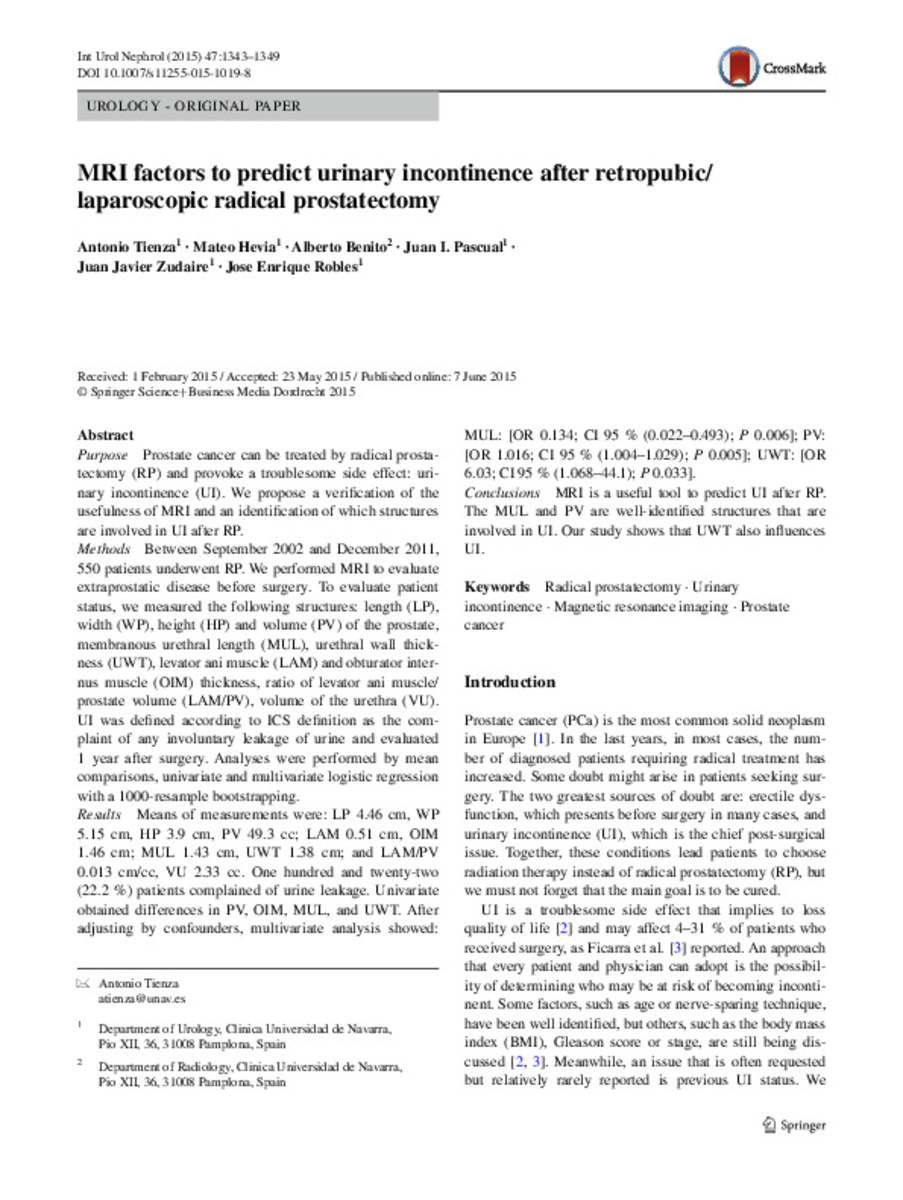Full metadata record
| DC Field | Value | Language |
|---|---|---|
| dc.creator | Robles-Garcia, J.E. (José Enrique) | - |
| dc.creator | Tienza, A. (Antonio) | - |
| dc.creator | Hevia, M. (Mateo) | - |
| dc.creator | Benito, C. (C.) | - |
| dc.creator | Pascual, J.I. (Juan Ignacio) | - |
| dc.creator | Zudaire-Bergera, J.J. (Juan Javier) | - |
| dc.date.accessioned | 2024-02-08T08:39:37Z | - |
| dc.date.available | 2024-02-08T08:39:37Z | - |
| dc.date.issued | 2015 | - |
| dc.identifier.citation | Robles-Garcia, J.E. (José Enrique); Tienza, A. (Antonio); Hevia, M. (Mateo); et al. "MRI factors to predict urinary incontinence after retropubic/laparoscopic radical prostatectomy". International Urology and Nephrology. 47, 2015, 1343 - 1349 | es_ES |
| dc.identifier.uri | https://hdl.handle.net/10171/68898 | - |
| dc.description.abstract | Purpose: Prostate cancer can be treated by radical prostatectomy (RP) and provoke a troublesome side effect: urinary incontinence (UI). We propose a verification of the usefulness of MRI and an identification of which structures are involved in UI after RP. Methods: Between September 2002 and December 2011, 550 patients underwent RP. We performed MRI to evaluate extraprostatic disease before surgery. To evaluate patient status, we measured the following structures: length (LP), width (WP), height (HP) and volume (PV) of the prostate, membranous urethral length (MUL), urethral wall thickness (UWT), levator ani muscle (LAM) and obturator internus muscle (OIM) thickness, ratio of levator ani muscle/prostate volume (LAM/PV), volume of the urethra (VU). UI was defined according to ICS definition as the complaint of any involuntary leakage of urine and evaluated 1 year after surgery. Analyses were performed by mean comparisons, univariate and multivariate logistic regression with a 1000-resample bootstrapping. Results: Means of measurements were: LP 4.46 cm, WP 5.15 cm, HP 3.9 cm, PV 49.3 cc; LAM 0.51 cm, OIM 1.46 cm; MUL 1.43 cm, UWT 1.38 cm; and LAM/PV 0.013 cm/cc, VU 2.33 cc. One hundred and twenty-two (22.2 %) patients complained of urine leakage. Univariate obtained differences in PV, OIM, MUL, and UWT. After adjusting by confounders, multivariate analysis showed: MUL: [OR 0.134; CI 95 % (0.022–0.493); P 0.006]; PV: [OR 1.016; CI 95 % (1.004–1.029); P 0.005]; UWT: [OR 6.03; CI 95 % (1.068–44.1); P 0.033]. Conclusions: MRI is a useful tool to predict UI after RP. The MUL and PV are well-identified structures that are involved in UI. Our study shows that UWT also influences UI. | es_ES |
| dc.language.iso | eng | es_ES |
| dc.rights | info:eu-repo/semantics/openAccess | es_ES |
| dc.subject | Radical prostatectomy | es_ES |
| dc.subject | Urinary incontinence | es_ES |
| dc.subject | Magnetic resonance imaging | es_ES |
| dc.subject | Prostate cancer | es_ES |
| dc.title | MRI factors to predict urinary incontinence after retropubic/laparoscopic radical prostatectomy | es_ES |
| dc.type | info:eu-repo/semantics/article | es_ES |
| dc.relation.publisherversion | https://link.springer.com/article/10.1007/s11255-015-1019-8 | es_ES |
| dc.editorial.note | © Springer Science+Business Media Dordrecht 2015 | es_ES |
| dadun.citation.endingPage | 1349 | es_ES |
| dadun.citation.publicationName | International Urology and Nephrology | es_ES |
| dadun.citation.startingPage | 1343 | es_ES |
| dadun.citation.volume | 47 | es_ES |
Files in This Item:
Statistics and impact
Items in Dadun are protected by copyright, with all rights reserved, unless otherwise indicated.






